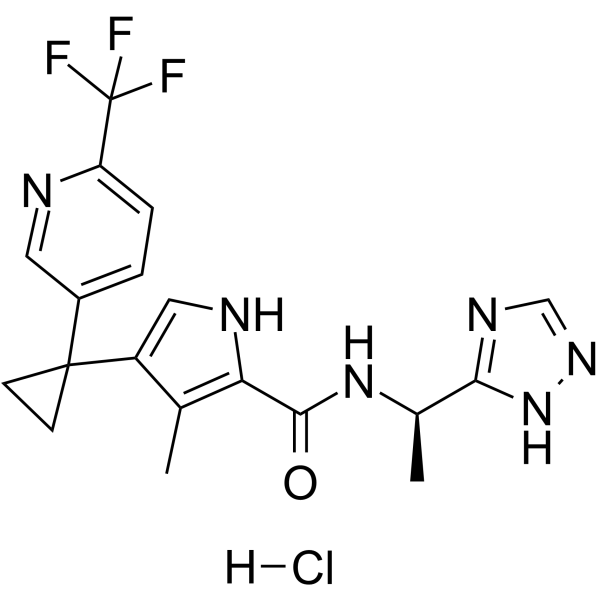Physicochemical Properties
| Molecular Formula | C19H20CLF3N6O |
| Molecular Weight | 440.85 |
| CAS # | 2989908-08-7 |
| Related CAS # | DSM705;2653225-38-6 |
| Appearance | White to off-white solid powder |
| HS Tariff Code | 2934.99.9001 |
| Storage |
Powder-20°C 3 years 4°C 2 years In solvent -80°C 6 months -20°C 1 month Note: Please store this product in a sealed and protected environment, avoid exposure to moisture. |
| Shipping Condition | Room temperature (This product is stable at ambient temperature for a few days during ordinary shipping and time spent in Customs) |
Biological Activity
| Targets | IC50: 95 nM (P. falciparum DHODH), 52 nM (P. vivax DHODH)[1] |
| ln Vitro | DSM705 hydrochloride exhibits inhibitory activity with no inhibition of the human enzyme against P. falciparum DHODH (PfDHODH, IC50=95 nM), P. vivax DHODH (PvDHODH, IC50=52 nM), and Pf3D7 cells (EC50=12 nM)[1]. |
| ln Vivo | At a dose of 50 mg/kg, DSM705 (3-200 mg/kg; po twice a day for 6 days) hydrochloride offers the highest rate of parasite killing and completely suppresses parasitemia by days 7-8[1]. Among Swiss outbred mice, DSM705 (2.6 and 24 mg/kg; a single po) hydrochloride shows high oral bioavailability (74%, 70%), apparent t1/2 (3.4, 4.5 h), and Cmax (2.6, 20 μM)[1]. Mice treated with DSM705 (2.3 mg/kg; one IV) hydrochloride show plasma clearance (CL=2.8 mL/min/kg) and Vss (1.3 L/kg)[1]. |
| Animal Protocol |
Animal/Disease Models: SCID (severe combined immunodeficient) mouse were inoculated with parasites[1] Doses: 3, 10, 20, 50, 100, 200 mg/kg Route of Administration: Po twice a day for 6 days Experimental Results: Killed parasite in a dose dependent manner and fully suppressed parasitemia by days 7-8. Animal/Disease Models: Swiss Outbred Mice[ 1] Doses: 2.6 and 24 mg/kg for po; 2.3 mg/kg for iv (pharmacokinetic/PK Analysis) Route of Administration: A single po and iv Experimental Results: Po: F=74/70%, t1/2=3.4/4.5 h, Cmax=2.6/20 μM. Iv: CL=2.8 mL/min/kg, Vss=1.3 L/kg. |
| References |
[1]. Potent Antimalarials with Development Potential Identified by Structure-Guided Computational Optimization of a Pyrrole-Based Dihydroorotate Dehydrogenase Inhibitor Series. J Med Chem. 2021 May 13;64(9):6085-6136. |
Solubility Data
| Solubility (In Vitro) | DMSO :~100 mg/mL (~226.83 mM) |
| Solubility (In Vivo) |
Solubility in Formulation 1: ≥ 2.5 mg/mL (5.67 mM) (saturation unknown) in 10% DMSO + 40% PEG300 + 5% Tween80 + 45% Saline (add these co-solvents sequentially from left to right, and one by one), clear solution. For example, if 1 mL of working solution is to be prepared, you can add 100 μL of 25.0 mg/mL clear DMSO stock solution to 400 μL PEG300 and mix evenly; then add 50 μL Tween-80 to the above solution and mix evenly; then add 450 μL normal saline to adjust the volume to 1 mL. Preparation of saline: Dissolve 0.9 g of sodium chloride in 100 mL ddH₂ O to obtain a clear solution. Solubility in Formulation 2: ≥ 2.5 mg/mL (5.67 mM) (saturation unknown) in 10% DMSO + 90% (20% SBE-β-CD in Saline) (add these co-solvents sequentially from left to right, and one by one), clear solution. For example, if 1 mL of working solution is to be prepared, you can add 100 μL of 25.0 mg/mL clear DMSO stock solution to 900 μL of 20% SBE-β-CD physiological saline solution and mix evenly. Preparation of 20% SBE-β-CD in Saline (4°C,1 week): Dissolve 2 g SBE-β-CD in 10 mL saline to obtain a clear solution. Solubility in Formulation 3: ≥ 2.5 mg/mL (5.67 mM) (saturation unknown) in 10% DMSO + 90% Corn Oil (add these co-solvents sequentially from left to right, and one by one), clear solution. For example, if 1 mL of working solution is to be prepared, you can add 100 μL of 25.0 mg/mL clear DMSO stock solution to 900 μL of corn oil and mix evenly. (Please use freshly prepared in vivo formulations for optimal results.) |
| Preparing Stock Solutions | 1 mg | 5 mg | 10 mg | |
| 1 mM | 2.2683 mL | 11.3417 mL | 22.6835 mL | |
| 5 mM | 0.4537 mL | 2.2683 mL | 4.5367 mL | |
| 10 mM | 0.2268 mL | 1.1342 mL | 2.2683 mL |
